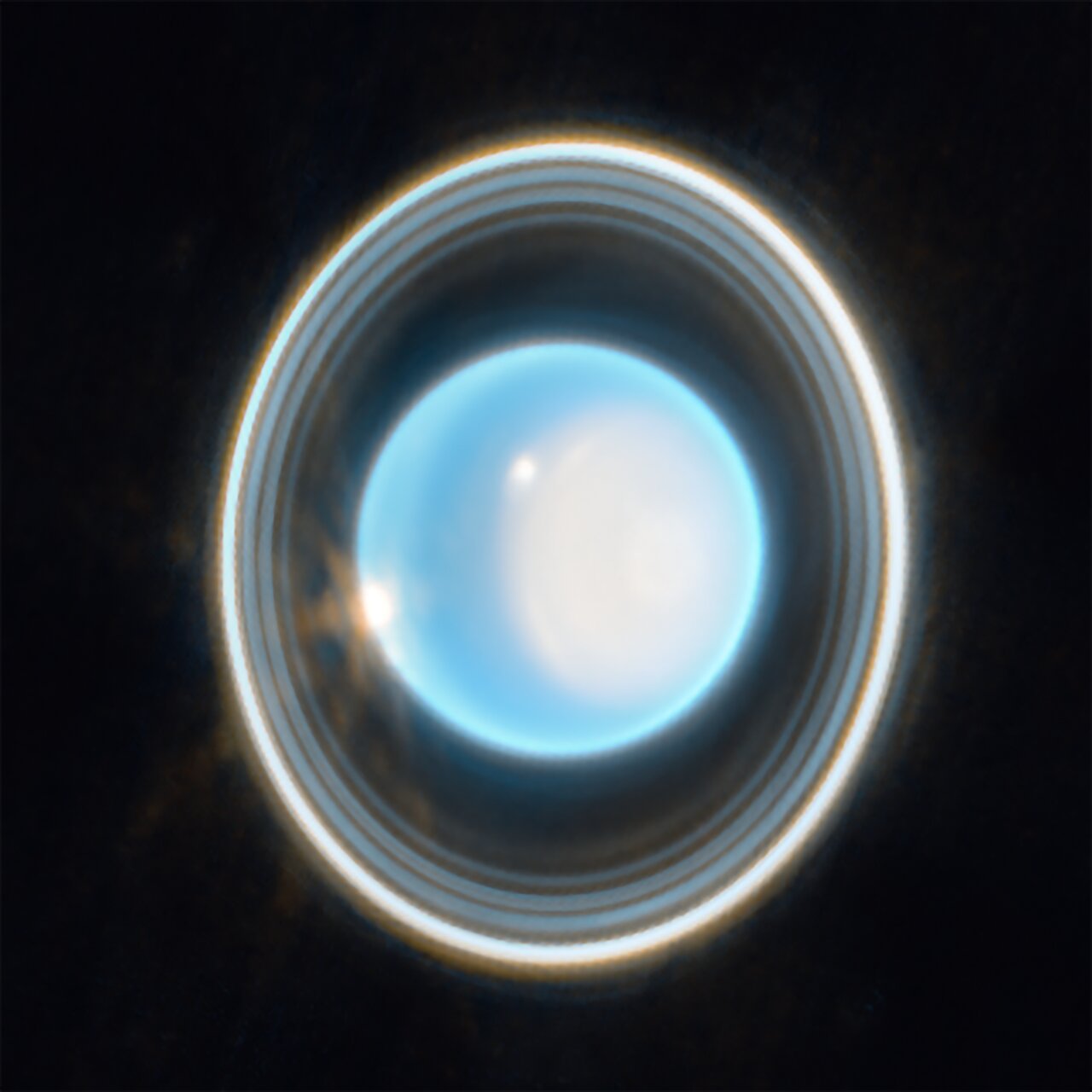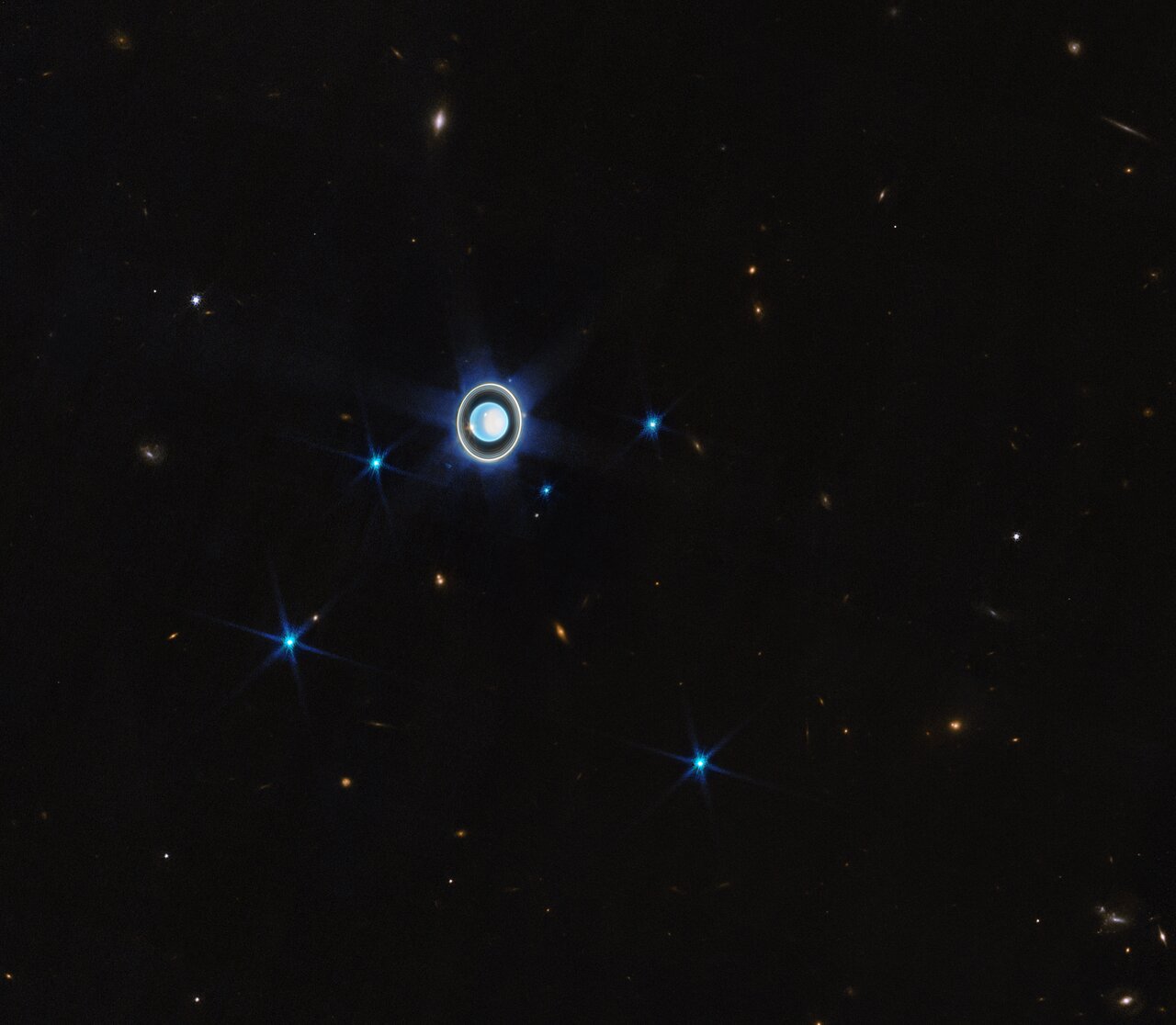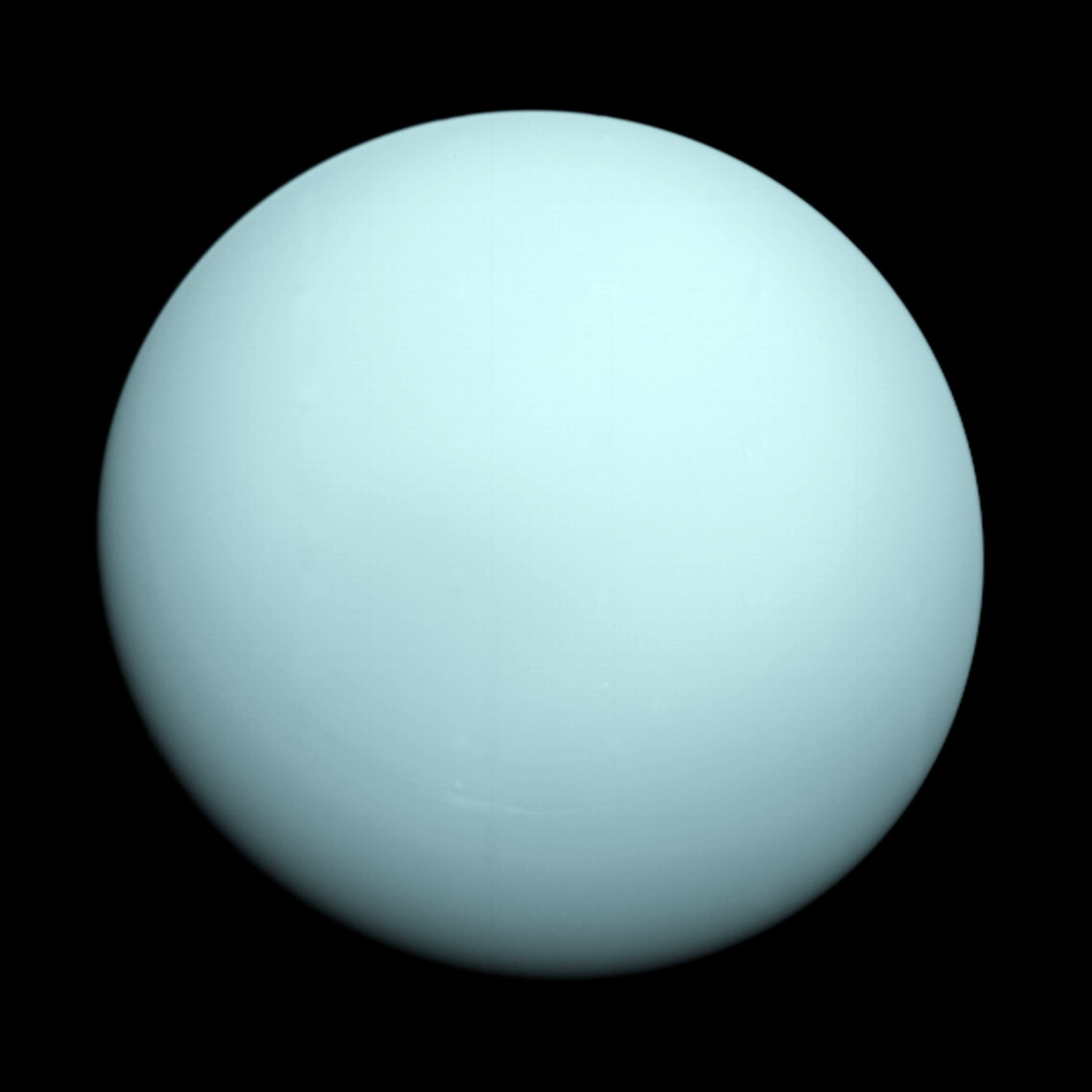
Posted on 04/07/2023 12:34:34 PM PDT by Red Badger
Webb’s infrared image highlights the planet’s dramatic rings and dynamic atmosphere.

This zoomed-in image of Uranus, captured by Webb’s Near-Infrared Camera (NIRCam) on 6 February 2023, reveals stunning views of the planet’s rings. The planet displays a blue hue in this representative-colour image, made by combining data from two filters (F140M, F300M) at 1.4 and 3.0 microns, shown here as blue and orange, respectively.
On the right side of the planet is an area of brightening at the pole facing the Sun, known as a polar cap. This polar cap is unique to Uranus because it is the only planet in the Solar System that is tilted on its side, which causes its extreme seasons. A new aspect of the polar cap revealed by Webb is a subtle brightening near the Uranian north pole.
At the edge of the polar cap lies a bright cloud and a few fainter extended features can be seen just beyond the cap’s edge; a second very bright cloud is seen at the planet’s left limb. Such clouds are typical for Uranus at infrared wavelengths, and are likely connected to storm activity.
[Image description: The planet Uranus on a black background. The planet appears light blue with a large, white patch on the right side. On the edge of that patch at the upper left is a bright white spot. Another white spot is located on the left side of the planet at the 9 o’clock position. Around the planet is a system of nested rings. The rings of Uranus are vertical.]
Credit: NASA, ESA, CSA, STScI, J. DePasquale (STScI)
======================================================================================

This annotated, zoomed-in image of Uranus, captured by Webb’s Near-Infrared Camera (NIRCam) on 6 February 2023, reveals stunning views of the planet’s rings, as well as clouds and the polar cap.
On the right side of the planet is an area of brightening at the pole facing the Sun, known as a polar cap. This polar cap is unique to Uranus because it is the only planet in the Solar System that is tilted on its side, which causes its extreme seasons. A new aspect of the polar cap revealed by Webb is a subtle brightening near the Uranian north pole.
At the edge of the polar cap lies a bright cloud and a few fainter extended features can be seen just beyond the cap’s edge; a second very bright cloud is seen at the planet’s left limb. Such clouds are typical for Uranus at infrared wavelengths, and are likely connected to storm activity.
The planet displays a blue hue in this representative-colour image, made by combining data from two filters (F140M, F300M) at 1.4 and 3.0 microns, which are assigned to blue and orange, respectively.
[Image description: The planet Uranus on a black background. The planet appears light blue with a large, white patch on the right side. The image is labelled to indicate the locations of the planet’s clouds, polar cap, and zeta ring.]
Credit: NASA, ESA, CSA, STScI, J. DePasquale (STScI)
===========================================================

This wider view of the Uranian system with Webb’s NIRCam instrument features the planet Uranus as well as six of its 27 known moons (most of which are too small and faint to be seen in this short exposure). A handful of background objects, including many galaxies, are also seen.
[Image description: The planet Uranus is on a black background just left of centre. Just below the planet at the 7 o’clock position is a faint blue point labeled Puck. Brighter blue points at 8 o’clock, 5 o’clock, and 3 o’clock are labeled Ariel, Miranda, and Umbriel, respectively. Two additional blue points at 7 o’clock and 5 o’clock are labeled Titania and Oberon]
Credit: NASA, ESA, CSA, STScI, J. DePasquale (STScI)
===========================================================
Following in the footsteps of the Neptune image released in 2022, the NASA/ESA/CSA James Webb Space Telescope has taken a stunning image of the Solar System’s other ice giant, the planet Uranus. The new image features dramatic rings as well as bright features in the planet’s atmosphere. The Webb data demonstrate the observatory’s unprecedented sensitivity by revealing the faintest dusty rings, which have only ever been imaged by two other facilities: the Voyager 2 spacecraft as it flew past the planet in 1986, and the Keck Observatory with advanced adaptive optics.
The seventh planet from the Sun, Uranus is unique: it rotates on its side, at a nearly 90-degree angle from the plane of its orbit. This causes extreme seasons since the planet’s poles experience many years of constant sunlight followed by an equal number of years of complete darkness. (Uranus takes 84 years to orbit the Sun.) Currently, it is late spring at the northern pole, which is visible here; Uranus’s northern summer will be in 2028. In contrast, when Voyager 2 visited Uranus it was summer at the south pole. The south pole is now on the ‘dark side’ of the planet, out of view and facing the darkness of space.
This infrared image from Webb’s Near-Infrared Camera (NIRCam) combines data from two filters at 1.4 and 3.0 microns, shown here in blue and orange, respectively. The planet displays a blue hue in the resulting representative-colour image.
When Voyager 2 looked at Uranus, its camera saw an almost featureless blue-green ball at visible wavelengths. At infrared wavelengths, and with Webb’s greater sensitivity, we see more detail, showing how dynamic the atmosphere of Uranus really is.
On the right side of the planet is an area of brightening at the pole facing the Sun, known as a polar cap. This polar cap is unique to Uranus — it seems to appear when the pole enters direct sunlight in the summer and vanishes in the autumn; these Webb data will help scientists understand the currently mysterious mechanism behind this feature. Webb has revealed a surprising aspect of the polar cap: a subtle enhanced brightening at the centre of the cap. The sensitivity of Webb’s NIRCam and the longer wavelengths it can see may explain why we can see this enhanced polar feature of Uranus when it has not been seen with other powerful telescopes like the NASA/ESA Hubble Space Telescope and the Keck Observatory.
At the edge of the polar cap lies a bright cloud and a few fainter extended features can be seen just beyond the cap’s edge; a second very bright cloud is seen at the planet’s left limb. Such clouds are typical for Uranus at infrared wavelengths, and are likely connected to storm activity.
This planet is characterised as an ice giant because of the chemical make-up of its interior. Most of its mass is thought to be a hot, dense fluid of ‘icy’ materials — water, methane and ammonia — above a small rocky core.
Uranus has 13 known rings and 11 of them are visible in this Webb image. Some of these rings are so bright as seen by Webb that when they are close together, they appear to merge into a larger ring. Nine are classed as the main rings of the planet, and two are the fainter dusty rings (such as the diffuse zeta ring closest to the planet) that weren’t discovered until the 1986 flyby by Voyager 2. Scientists expect that future Webb images of Uranus will reveal the two faint outer rings that were discovered with Hubble during the 2007 ring-plane crossing.
Webb also captured many of Uranus’s 27 known moons (most of which are too small and faint to be seen here); the six brightest are identified in the wide-view image. This was only a short (12-minute) exposure image of Uranus with just two filters. It is just the tip of the iceberg of what Webb can do when observing this mysterious planet. Additional studies of Uranus are happening now, and more are planned in Webb’s first year of science operations.
More information Webb is the largest, most powerful telescope ever launched into space. Under an international collaboration agreement, ESA provided the telescope’s launch service, using the Ariane 5 launch vehicle. Working with partners, ESA was responsible for the development and qualification of Ariane 5 adaptations for the Webb mission and for the procurement of the launch service by Arianespace. ESA also provided the workhorse spectrograph NIRSpec and 50% of the mid-infrared instrument MIRI, which was designed and built by a consortium of nationally funded European Institutes (The MIRI European Consortium) in partnership with JPL and the University of Arizona.
Webb is an international partnership between NASA, ESA and the Canadian Space Agency (CSA).
Image Credit: NASA, ESA, CSA, STScI, J. DePasquale (STScI)

This wider view of the Uranian system with Webb’s NIRCam instrument features the planet Uranus as well as six of its 27 known moons (most of which are too small and faint to be seen in this short exposure). A handful of background objects, including many galaxies, are also seen.
[Image description: The planet Uranus is on a black background just left of centre. It is coloured light blue and displays a large, white patch on the right side as well as two bright spots and a surrounding system of nested rings oriented vertically.]
Credit: NASA, ESA, CSA, STScI, J. DePasquale (STScI)
Uranus is beautiful.......................
I’m not allowed to post on this thread...I’m too immature...
New images of my what? How did Webb get ahold of those?

There are rings around Uranus? Who knew!
Big Brother is everywhere!.........................
All the Gas Giants have at least one ring...............
Here’s one (rare!) family friendly reference on Uranus:
Composer Gustav Holst Opus 32 -6 Uranus: The Magician!
Uranus is named for an ancient Greek sky god called Ouranos.
The Romans called it Caelus, also known as a sky god.

By the way, an interesting fact is that all the moons of Uranus are named after characters in Shakespearean plays.

I’m not a big fan of how they always play around with the light on these, converting non-visible light spectrums to visible light for the pictures. It’s misleading IMO. Gives someone the impression that is how it would look to their eyes if they were closer.
We should be especially careful about when showing Uranus. We don’t want people eventually being disappointed when they realize Uranus is fairly dark and cold.
Party on Magnum44.
Awesome pic. Love the blue color.
Uranus is much cleaner-looking than I expected.
The USS Charmin is on the way...reporting for clean-up duty.
What I would like to see someday is a Cassini-type space probe travel to Uranus on a similar mission. The rings would be spectacular, no doubt.
Pesky Klingons circling Uranus. Every school kid knows that.
I truly hate enhanced pictures. it’s honestly no better than fake news... Subtle and basic enhancments I know are necessary but these clowns are just like the fake news media and have to out do each other at the cost of reality.
There is absolutely no way those rings are as bright or brighter than the damned planet. It would be sooooooooo much better if they dropped the Opacity of the ring enhancement to
15 or 20% of what it is in these pics... down right silly...
Disclaimer: Opinions posted on Free Republic are those of the individual posters and do not necessarily represent the opinion of Free Republic or its management. All materials posted herein are protected by copyright law and the exemption for fair use of copyrighted works.